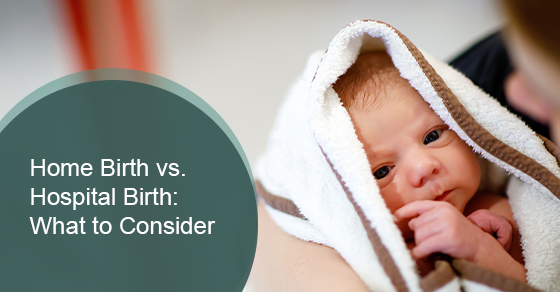Are you wondering whether a home birth or hospital birth is the right option for your labour and delivery? A large portion of women in Canada give birth at hospitals, but home births also make up a substantial number of deliveries in provinces like Ontario.
Home births have become increasingly popular these days, and they can be a safe option for low-risk pregnancies, but are they the best option for you? Keep reading to learn more about the pros and cons of home births and hospital births.
Deciding where you want to have your baby is a very personal decision. You will need to weigh out your personal concerns with each option before you can make the best choice.
Depending on your pregnancy, your healthcare provider might recommend that you plan for a hospital birth. This will be the case if your pregnancy is considered high-risk, you are having multiples, or there might be complications during your prenatal journey. During your planning, it’s most important to prioritize the health of you and your baby. This might mean giving birth in a healthcare facility with access to many licensed healthcare providers, equipment, and interventions that can be readily used to assist you during labour or delivery. This ensures the safest and least stressful outcome as possible.
With that being said, if your situation is different and you’ve been given permission by your healthcare provider to choose your birth setting, then there are a variety of reasons why some women might choose to deliver their little one at home.
Some Benefits of Going With a Home Birth
- Being able to deliver in a familiar, private environment with as many or as few support people nearby.
- Delivering in an environment with as few medical interventions as possible, and having labour support devices available in advance such as birthing balls, pools, or bath tubs.
- Being able to use a midwife and/or having more freedom and control during labour and delivery.
- Cultural and/or religious concerns.
One of the biggest downsides associated with giving birth at home is that there will be a lack of access to a hospital. It’s also important to understand that there might be a case where you must finish labour at a medical facility for the safest possible situation for both you and your baby.
For instance, if labour is not progressing after many hours, if the baby is in distress or breech, if your blood pressure becomes increasingly high or there is excessive bleeding, or if you reach a point where the pain is too strong and you need more pain medication, then you should make plans to be transported to the hospital to receive the interventions necessary to finish delivering. While these situations are not guaranteed to occur, it’s always best to be prepared for anything and to have an emergency birth plan in place in the event you need to be taken to the hospital.
What Hospital Births Have to Offer
In general, hospital births are much safer due to being close to a team of health practitioners who are always available if an emergency should arise. It’s hard to tell which expectant mother will have an obstetric emergency. Anywhere between 23 and 37 percent of first-time mothers attempting a home birth end up going to a hospital because the baby is unable to move through the birth canal.
However, hospital births still carry risks. The likelihood of undergoing a caesarean section is a lot higher in a hospital setting. C-sections carry risks like blood loss, pain, and infections. Also, if a woman were to undergo a c-section, it is much more likely for her to require the same in future deliveries. In addition, during a hospital birth, a mother is at a higher risk for an episiotomy (or vaginal incision) and infection.
As well, in all hospital births (and home births), there is the risk of undergoing hospital errors committed by health practitioners. Hospital error cases involve doctors, nurses, midwives, and any other health care providers. Some of the most common hospital errors can include:
- Improper caesarean section;
- Bowel perforation;
- Or poor overall management.
There is definitely a lot to consider when trying to decide between a home birth and a hospital birth, but the decision is ultimately up to you and your personal preferences. Just remember that both home and hospital births should be planned in advance, and you should speak extensively with your care team during the decision-making process.
Reach Out to Our Expert Birth Injury Lawyers at Sommers Roth & Elmaleh
For over 40 years, Sommers Roth & Elmaleh has won multimillion dollar settlements for our clients that help them pay for their child’s care, therapies, equipment, medical supplies, housing, transportation, and other expenses. At Sommers Roth & Elmaleh, we can help walk you through the process of making an obstetric malpractice claim, and explain the type of compensation you can expect to obtain.
Sommers Roth & Elmaleh are Experienced Medical Malpractice Lawyers Helping Clients Get Financial Compensation in Obstetric Malpractice Cases
If you or your child has suffered a birth injury due to a medical error or due to the negligence of a healthcare professional, contact Sommers Roth & Elmaleh for trusted legal advice and guidance. Our lawyers are well-known and well respected in the legal and medical cases. We have assisted clients in Ontario, Alberta, British Columbia, and Quebec. We offer compassionate, skilled, and knowledgeable guidance for all aspects of obstetric malpractice claims.
For more information about hospital errors, call us at 1-844-777-7372 or contact us online for a free consultation.

